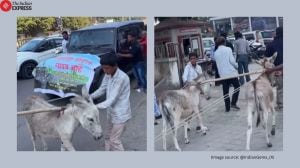One of the major concerns most experts flagged is that the new draft policy has been announced at a time when the country is yet to finalise the countours of a data protection law. The policy, they said, could also face pushback from big tech companies whose business model is based on the monetisation of large-scale data collection model, similar to the one proposed by the IT ministry.


“The government had made its intentions of monetising data clear quite sometime back. The thought process to consider non personal data as community or national resource, in itself is commendable. However data monitisation should not happen at cost of individual privacy else,” said Salman Waris, Partner at TechLegis.
Story continues below this ad
The idea of monetising citizens data for greater public good was first floated by the government in the Economic Survey of 2018-19, which had noted that since such data is generated and belongs to the people, it should be used for the people. The survey had also noted that private sector could be granted access to “select databases” for commercial use.
The problem with this, said Apar Gupta, executive director at policy advocacy group Internet Freedom Foundation, is that it gives a “perverse incentive for the government to collect more citizen data”, which in turn may lead to further imbalance of the power imbalance between the state and the citizens.

“The core problem with the government selling citizens’ data is the revenue generation. The political risk of gathering more information is well established. The problem with this policy particularly is that when you start selling citizen data, even if anonymised, the government gets into business its making money. And once you start making money, its very hard for you to reduce that activity or to regulate it in a manner where you are impartial to the public,” Gupta told The Indian Express.
Experts have also flagged concerns around the lack of proper standards and framework on data anonymisation, and said that it is possible that such data may be “reverse-engineered”, thereby making re-identification of the generators of the data very easy.
Story continues below this ad
“The stress on High Value Datasets is also worrying since often the most sought after datasets are those that contain sensitive personal data of individuals, for example medical history, financial data. Considering a number of personal and sensitive personal data will be shared, the anonymisation standard should be of the highest possible standard,” said Shweta Mohandas, a researcher at the Centre for Internet and Society.
Some experts also pointed to the lack of details on what constitutes value addition and the pricing or licensing mechanism on the same.
“While this is an interesting manner in which the government can monetise the wide range of data it currently holds, it remains to be seen how the pricing mechanism would work. It is important to understand that datasets can not be priced uniformly, and the value of a particular dataset varies depending on the context in which it is solved,” said Kazim Rizvi, the Founder public policy think tank The Dialogue.
What does the draft of the India Data Accessibility and Use Policy propose?
Apart from suggesting that the data, which has been collected by the central government and undergone some value addition be allowed to be sold for some price, the draft of the policy also suggests new framework for identifying “high value data-set” on the basis of the data’s degree of importance in the market.
Story continues below this ad
The draft also suggests that a new framework for identifying “high value data-set” on the basis of the data’s degree of importance in the market be put in place. All the ministries and departments of the Central government will have to “identify, publish and maintain” their high-value dataset.
The draft has also suggested setting up of a central India Data Office will be created under MeitY, while all the central government’s line ministries will have to form their respective Data Management Unit, which will be headed by a Chief Data Officer. These chief data officers along with the India Data Officer will together form the India Data Council, which will decide on the policy matters of data accessibility and its usage.
The draft also proposes a data sharing toolkit, which will be the broad umbrella to help respective central or state government ministries and departments “assess and optimally manage” the risks associated with the release and sharing of such data.
Newsletter | Click to get the day’s best explainers in your inbox










































